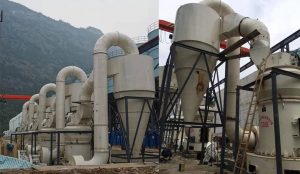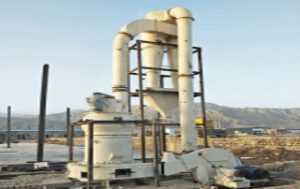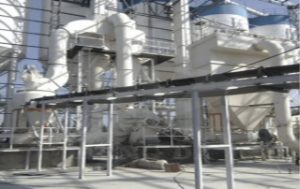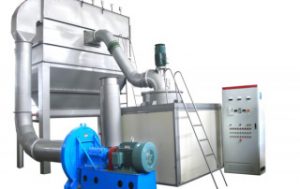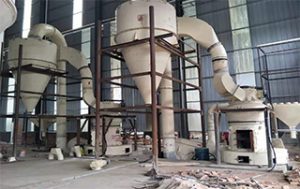Sealing plays an important role in preventing “three leaks” of mechanical products and ensuring the normal lubrication action and safe operation of equipment. The vertical mill has high requirements for sealing, especially for the grinding roller bearing. The oil seal is set between stationary and rotating parts to prevent lubricating oil leakage and prevent impurities such as external dust and materials from entering the inner cavity of the bearing chamber. It has the characteristics of simple structure, good sealing performance, shaft swing and eccentric follow-up performance. Therefore, it is widely used in the bearing seal of vertical grinding roller. The grinding roller is a key component in the vertical mill, and the bearings used are large bearings, which are expensive. Due to the poor internal working environment, high temperature, much dust, large vibration, gas humidity, oil leakage of the grinding roller or oil seal failure, it will directly affect the service safety of the bearing, reduce the service life of the bearing, and increase the equipment operation risk and maintenance cost. Therefore, the perfect roller sealing solution directly determines the reliability, use efficiency and operation and maintenance cost of the vertical grinding roller, and even affects the stability of the whole vertical grinding system.
1 sealing principle of grinding roller seal
The purpose of sealing is to set up a perfect physical barrier at a place where leakage may occur and it is necessary to seal it. Grinding roller seal belongs to the dynamic seal with narrow rotation of grinding roller. There are many schools of dynamic seal principles, including surface tension theory, adsorption theory and boundary lubrication theory. Among them, the crescent theory proposed by E. T. Jagger and the micropump theory proposed by horvel and others are more influential [1]. Now they are introduced respectively.
1.1 crescent theory
The skeleton oil seal is usually composed of a sealing body, a reinforced skeleton and a self tightening coil spring. In a free state, its inner diameter is smaller than that of the shaft and has a certain amount of interference. When the oil is encapsulated into the oil seal seat and the shaft, the pressure of the oil seal lip and the shrinkage force of the self tightening spring produce a certain radial pressure on the shaft surface, plus the pressure of the lubricating oil chamber, which jointly determines the friction with the shaft, When the oil seal rotates initially, the friction torque is large, and then gradually decreases and tends to be stable. During operation, the oil seal lip forms a sealing contact ring belt under the action of contact pressure, and the lubricating oil penetrates into the sealing contact ring belt to form an oil film, which has fluid lubrication characteristics. Under the action of liquid surface tension, the stiffness of oil film just makes the contact end between oil film and air form a crescent to prevent the leakage of working medium, so as to realize sealing. The sealing capacity of the oil seal depends on the thickness of the oil film on the sealing surface. If the thickness is too large, the oil seal will leak; If the thickness is too small, friction may occur, causing wear of oil seal and shaft surface; If there is no oil film between the sealing lip and the shaft, it is easy to cause heating and wear. Therefore, during installation, some grease must be applied on the oil seal, and ensure that the skeleton oil seal is perpendicular to the axis line of the shaft. If it is not perpendicular, the sealing lip of the oil seal will drain the lubricating oil from the shaft and cause excessive wear of the sealing lip.
1.2 micropump theory
Because the inner diameter of the oil seal is smaller than the diameter of the shaft, they belong to interference fit. Coupled with the action of the spring, the contact pressure in the contact area is asymmetrically distributed, and different pressure changes are generated at the oil storage end and air end of the oil seal, resulting in two-way different pump oil action to make the lubricating oil flow in a fixed direction, so as to achieve the purpose of sealing.
Cause analysis of sealing failure of 2 grinding roller
The parts of lubricating oil leakage of grinding roller caused by seal failure are mainly the joint of oil seal lip and grinding roller shaft sleeve (oil seal pair), and the joint of oil seal matrix and oil seal cavity. The main causes of failure include the problems of shaft (sleeve), oil seal, coordination, installation, use and maintenance [2].
2.1 problems of shaft (sleeve)
1) Surface roughness of shaft (sleeve): the surface roughness of the shaft is very critical to the sealing. If the surface roughness of the shaft is too large, the convex summit of the shaft surface passes through the oil film and contacts the sealing lip, which is easy to scratch the lip when the oil seal rotates, resulting in rapid wear of the lip and seal failure; If the surface roughness of the shaft is too small, the oil is easy to squeeze out from the seal contact, resulting in thinning or rupture of the oil film, increasing friction and wear, damaging the seal and failure. Therefore, the surface roughness of the shaft has an appropriate range, and RA is generally controlled at 0.4 ~ 0.8 μ m。
2) Surface hardness of shaft (sleeve): since the shaft surface in contact with the lip oil seal is under the friction of the lip for a long time during operation, it is easy to wear the shaft diameter over time. Therefore, the surface hardness of shaft (sleeve) here should be improved and generally controlled above 50HRC.
3) Surface machining status and geometric tolerance of shaft (sleeve): if there are machining marks and damage on the surface of shaft (sleeve), oil seal leakage will be caused. Similarly, if the roundness and runout of shaft (sleeve) exceed the adaptability of oil seal, oil seal leakage will also be caused.
2.2 factors of oil seal
1) The structural design of oil seal is unreasonable. In order to obtain a leak free lip oil seal, in addition to selecting appropriate elastic materials, the shape and position of the sealing belt and the relative position of the sealing belt and spring play a very important role. The sealing surface is formed by two intersecting conical surfaces, the front lip angle( α) It refers to the included angle between the front lip surface of the sealing lip and the axis, and the rear lip angle( β) It refers to the included angle between the rear lip surface of the sealing lip and the axis. It is required in design α>β, At the same time, in order to obtain good sealing effect, generally take α= 40°~60°, β= 20 ° ~ 25 °. There shall be an axial offset between the spring center and the lip seal center, and its value is generally r = 0.4 ~ 0.7mm. When the R value is too small or even tends to zero, the oil film cannot be maintained, which is not conducive to sealing; if the R value is too large, the friction heat generation will increase, the contact width will increase, and the contact stress will decrease, resulting in the “critical oil film” between the oil seal lip and the shaft Lubrication expands into fluid lubrication, causing leakage.
2) improper selection of oil seal material. No high temperature resistance, anti-aging, wear resistance, pressure resistance, corrosion resistance and other factors were considered.
3) The manufacturing process of oil seal is unreasonable and the dimensional accuracy is poor.
4) The poor quality or failure of the oil seal spring makes the holding force of the oil seal to the shaft too small.
2.3 problems of cooperation
1) The quality of oil seal seat for installing oil seal is poor.
2) The box seat hole, end cover and output shaft are not concentric. When the lip oil seal is newly installed, the average contact load is about 1MPa, which is equivalent to the load on the unit axial length of 200N / m. after long-time operation, the contact load slowly attenuates, and the attenuated load shall be maintained at least 50% of the initial load, i.e. 100N / M; When the box seat hole, end cover and output shaft are not concentric, it can cause uneven contact between the oil seal lip and the shaft sleeve, resulting in inconsistent pressing force of the oil seal lip on the shaft sleeve, and the load per unit axial length can exceed 400N / m. Generally speaking, when the load is 100N / m, the service life of oil seal is the longest, and when the load exceeds 400N / m, the service life of oil seal is the shortest.
3) Long term high temperature causes rubber aging and hardening. Based on the high-temperature working environment in the mill and the heat generated by the rotation of the oil seal, the temperature at the lip of the oil seal is generally about 120 ℃, and the long-term operation promotes the aging and failure of the oil seal.
2.4 installation, use and maintenance
1) When the oil seal is used, it is not checked whether there is damage before use, and the direction of the main lip of the seal is not correctly confirmed.
2) Scratch the lip during assembly.
3) The shaft end and shoulder are too rough, the assembly force is uneven, or the one-time pressing thickness is too large, resulting in the overturning of the oil seal lip or the falling off of the spring.
4) The oil seal is not pressed in place during assembly, damaging the lip.
5) Insufficient understanding of the service life of the oil seal, and overdue use leads to aging and damage of the oil seal and seal failure.
6) The structure that can be filled with grease regularly is not considered in the design, or the grease is not filled at the oil seal in time, resulting in dry friction of the oil seal and damage due to temperature rise.
3 hazards of roller seal failure
Seal is the weakest link in the vertical grinding roller system composed of bearing, lubrication and seal. According to statistics, more than 67% of bearing failures are caused by seal failure. The sealing failure of the grinding roller will make the material micro powder and water enter the grinding roller, resulting in lubricating oil pollution and emulsification failure, so that the effective oil film thickness cannot be formed, resulting in bearing rust, pitting corrosion, wear and even final fracture. In serious cases, the whole grinding roller will be stuck, resulting in large mill vibration, reduced output, shutdown and other serious consequences.
4 requirements for sealing elements of grinding roller seal
1) The pressure bearing capacity of the seal shall not be less than 0.3MPa. There shall be no independent spring design inside to reduce the seal failure caused by seal deformation and spring falling off. At the same time, it shall have sufficient axial clamping force to ensure the sealing performance.
2) The seal shall have excellent lip profile design to fully meet the harsh service requirements such as high temperature (100 ~ 200 ℃), low speed, heavy load and continuous vibration in the mill, as well as the sealing performance in case of slight misalignment between the shaft and the oil seal seat hole.
3) The seal shall have good oil resistance, and at the same time, it can bring excellent oil pumping capacity through the extruded lip, so as to block pollutants, moisture and fine powder of materials from the outside, especially with the prevention size of about 5 ~ 80 μ The ability of material particles of m to enter the bearing chamber.
4) The seal shall have good wear resistance and low friction coefficient, can automatically compensate the wear and geometric accuracy error to a certain extent, and is not easy to aging.
5) On the basis of normal use and good lubrication, the service life is required to be at least 2 years.
5 grinding roller bearing sealing solution
5.1 original sealing scheme and its disadvantages
The original vertical grinding roller bearing seal is composed of three oil seal seals, and its structural scheme is shown in Figure 1.
Fig. 1 sealing structure of original vertical grinding roller bearing
The disadvantages of the sealing structure are as follows:
1) The design seal consists of three oil seals, of which the main lips of the inner two oil seals face the bearing side to prevent oil, and the outermost oil cover faces the inner side of the mill to prevent dust (mainly material micro powder). Because the outermost oil seal is in direct contact with air, it is very easy to be polluted and damaged by materials, forming a path for materials to enter the bearing chamber, As a result, the inner two oil drain oil seals fail, resulting in the failure of the whole sealing system, resulting in serious consequences such as oil leakage of grinding roller and bearing failure.
2) The original oil seal material is nitrile rubber. When the lubrication is poor, the heat will increase, which will easily lead to the aging of the oil seal lip and seal failure.
3) The oil seal pair is made of ordinary Q235A or 45 steel with insufficient hardness. It is very easy to grind out grooves at the contact between the oil seal pair and the lip, resulting in damage and failure of the oil seal. The fine metal scraps produced by wear will also endanger the safety of the bearing.
4) Due to the simultaneous action of three oil seals, it is easy to install the oil seal lip in the opposite direction during installation, and it is difficult to avoid lip turning during installation.
5) The original design does not consider the bearing capacity of the oil seal in terms of the hardness, roughness, machining accuracy and geometric tolerance of the oil seal seat cavity and oil seal pair, which is very prone to internal damage.
5.2 new sealing scheme of grinding roller bearing
In view of the shortcomings of the original seal, a new sealing solution for grinding roller bearing is proposed, that is, the new scheme of two skeleton oil seals + V-shaped dust seal + wear-resistant shaft sleeve is adopted. Its structure is shown in Figure 2.
Fig. 2 sealing structure of new grinding roller bearing
5.3 advantages of new sealing scheme
1) Sealing and dustproof are realized by independent functional elements respectively, so as to achieve functional optimization.
2) V-shaped dust seal adopts unique design, and its performance is much better than that of ordinary V-shaped seal in the market. It is installed on the rotating part, which can reverse the dust, particles and other foreign matters collected when it rotates with the oil seal seat and be blown back to the grinding disc by the sealing air.
3) The axial direction adopts the design of two oil seals. The lip of the oil seal adopts the lip profile optimized by computer FEA finite element method. The main lip of the oil seal on the side close to the inside of the grinding roller bearing faces inward, which can effectively prevent the leakage of circulating oil. The main lip of the oil seal on the side away from the inside of the grinding roller bearing faces outward, which plays the role of dust prevention and dust retaining, and can effectively prevent dust from entering the bearing lubrication system.
4) During installation, the corresponding sealing contact surface shall be filled with grease in advance to ensure a certain lubrication at the sealing part and improve the service life; On the other hand, it plays the role of dust prevention; At the same time, in order to ensure the normal lubrication of the equipment, a lubricating oil channel is set on the shaft to facilitate the regular filling of lubricating grease.
5) The bearing steel wear-resistant shaft sleeve has high hardness. When used with oil seal, the service life of both can be effectively increased. After damage, only the shaft sleeve itself needs to be replaced without worrying about the damage to the shaft.
6) In the design, the shaft sleeve material is optimized, and the hardness, roughness, wall thickness of the shaft sleeve and oil seal seat, as well as the dimensional tolerance, geometric tolerance and other parameters required for matching are also optimized.
5.4 comparison between new sealing scheme and original sealing scheme
The comparison between the new sealing scheme and the original sealing scheme is shown in Table 1.
Table 1 Comparison between new sealing scheme and original sealing scheme
5.5 function of wear-resistant bushing
Due to impurity particles and friction between the rotating shaft and the seal, the shaft or shaft sleeve will be seriously damaged. At present, the common treatment method in the vertical grinding industry is brush plating on the shaft or replacing a new shaft sleeve, but brush plating is difficult to process and the repair effect is difficult to ensure; The service life of ordinary shaft sleeve is very short. When replacing shaft sleeve and oil seal, the whole grinding roller needs to be lifted out of the mill, which is time-consuming and laborious. Practice has proved that the use of large-diameter wear-resistant bushing can effectively prolong the service life of oil seal and reduce the maintenance cost of frequent replacement of shaft sleeve, shutdown, installation and disassembly.
Design features of large diameter wear-resistant bushing: it is made of high-quality sae1008 carbon steel with chromium coating to enhance wear resistance and corrosion resistance; The outer diameter of the bushing is specially ground to provide a precise mating surface for the seal; The wall thickness of the standard bushing is 2.39mm, which is easy to replace after the bushing is worn. The standard bushing continuously improves the service life of the oil seal and effectively improves the reliability of the vertical grinding system.
6 Conclusion
The new sealing scheme of grinding roller bearing with two skeleton oil seals, V-shaped dust seals and wear-resistant shaft sleeves has been used in about 200 sets of grinding roller devices. So far, the probability of lubricating oil leakage accident of grinding roller is only 1%, and the probability of bearing failure caused by sealing failure is only 0.5%. Practice has proved that the roller grinding device with the new sealing structure has good sealing effect, the service life of seals is generally prolonged, the probability of oil seal leakage accident is greatly reduced, the roller bearing is effectively protected, the shutdown times and time of vertical mill are reduced, and the reliability of vertical mill system is improved.


